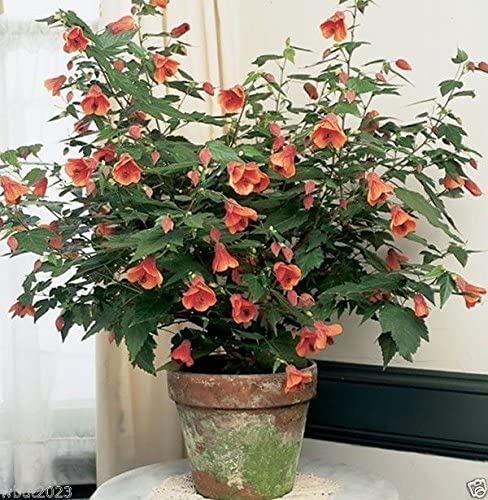
Flowering Maple, or Abutilon, is a large genus of flowering plants in the mallow family. Abutilons are hardy evergreen shrubs that are not difficult to grow. These shrubs have maple-like leaves; hence they are known by the common name Flowering Maple.
Moreover, they bloom all summer long with bell-like flowers that look like mallow, that is why they second common name is Indian Mallow. Abutilon megapotamicum is a hardy species of Abutilons which grows to 4 feet in height and is native to Argentina, Brazil, and Uruguay. When growing in perfect environment, they never stop blooming. They are often used as seasonal annuals or houseplants in Northern climates. Flower colors range from white to reds, yellow, orange, coral and bicolor.
To maintain a dense, compact form they need to be pinched regularly. This will also promote more blooms as they only flower on new wood. Pinching, pruning, and keeping a plant slightly root bound will help control its size. Major pruning should be done in early spring or late fall. Cut back branches selectively to shape the plant, making the cuts just above a node or on a strong, vigorous shoot near the plant’s base.
How to Care for a Flowering Maple Houseplant
Flowering maple houseplants should be placed in areas of full sun to very light shade in a moist, well-draining soil medium. Light shade placement will prevent wilting during the hottest parts of the day. The Abutilon flowering maple tends to get rangy; to prevent this, pinch the tops of the branches in the spring to encourage a more compact habit. Other Abutilon requirements indoors are to water well but avoid overwatering, especially in the winter when the plant is in a dormant phase.
Fun Facts About Flowering Maples
Flowering maples were popular during the Victorian era and then fell out of favor in the gardening world but have returned to modern gardens in a plethora of forms.
The genus Abutilon is a large group of flowering plants in the mallow family (Malvaceae) with over 200 species occurring throughout the tropics and subtropics. They range in height from 18 inches to 10 feet, and may be herbaceous perennials, shrubs, or small trees.
Many varieties are attractive to butterflies and hummingbirds. Hybrids rarely set fruit, but the species do produce hemispherical pods (schizocarps) with multiple segments, each containing a few seeds.
Related Articles & Free Email Newsletter Sign Up
How to Boost the Health and Beauty of Your Houseplants
How to Grow Bonsai Trees for Beginners




Comment here